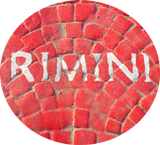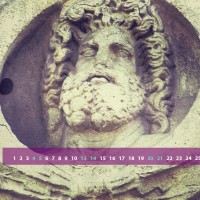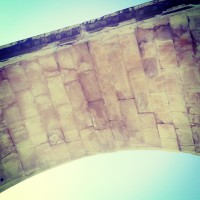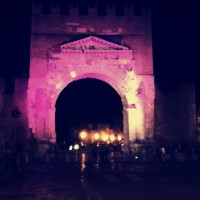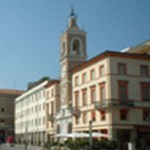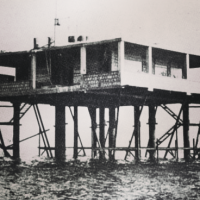Arco d’Augusto (The Arch of Augustus)
Rimini’s Arco di Augusto (The Augustus Arch) is the oldest surviving Roman triumphal archway in existence. It highlights the importance of Rimini in the Roman world, and is the most iconic monument of classical Rimini.
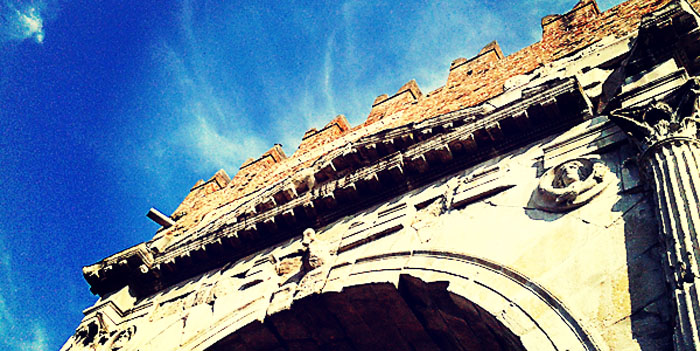
Arco d’Augusto- the oldest surviving Roman Triumphal Archway
The arch was built in 27 B.C. and dedicated to Augustus – at a time when Gaius Julius Caesar Augustus was succesfully consolidating his individual power – on the orders of the Senate. It was the start of the so-called Pax Romana, a prosperous and peaceful period which saw major building projects undertaken in Rimini including the Tiberius Bridge (actually started by Augustus in 14 A.D just before his death).
Today’s traveller from Rome to Milan will take either the railway line or autostrada that passes up through Florence and over the appenines to Bologna – but in classical times the route passed directly through Rimini (then known as Ariminum), hence this magnificent triumphal archway leading into the city at the end of the famous roman road, the Via Flaminia
The Via Flaminia, passing through Ariminum – the route used by travellers during the days of the Roman empire to travel between Rome and Milan
The classical traveller would then have proceeded along the Decumanus maximus, the main street of roman city planning (which corresponds to today’s Corso d’Augusto) until meeting with the Via Emilia – the roman road that crosses the po river plain up into Lombardy and Milano.
The original archway would have had a large statue of Augustus – most probably astride a quadriga chariot (similar to that found on top of the Brandenburg gate in Berlin, for example) – which has been lost to history.
The top of the Archway was modified in the Xth Century, when the structure took on a more important defensive role. An interesting bit of trivia is that historians believe the original archway was completely ornamental in purpose, as its archway was too wide to succesfully hang a gate for defence – something which, with the pax romana was deemed unneccesary.
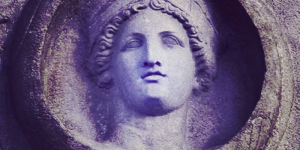 The larger part of the original structure remains however, with it’s grand yet sombre design. You can see clearly the reliefs of the four Roman gods to whom the gate was dedicated – Jupiter, Apollo, Neptune, and Roma, as well as the inscription dedicating the archway to Augustus.
The larger part of the original structure remains however, with it’s grand yet sombre design. You can see clearly the reliefs of the four Roman gods to whom the gate was dedicated – Jupiter, Apollo, Neptune, and Roma, as well as the inscription dedicating the archway to Augustus.
The modern day archway is flanked strangely by ruined walls – a footnote in history to the fascist period. When the fascists were in power in the 1920s, and all things Roman were to be lauded, the local authorities decided to demolish the defensive city walls on either side of this magnificent archway in order to remove it from its medieval context and place it firmly back to the days when Ariminum had a larger role to play. An ideological move which has left the archway looking somewhat stranded in the 21st century!
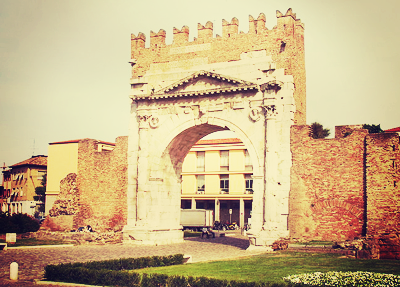
Jupiter on the Arco d’Augusto
Take a moment at Rimini's Arco d'Augusto, on the side facing away from the city (towards Rome) and l...
Read the full storyRimini adheres to earth hour
The comune of Rimini has added its support to the earth hour initiative, which will take place this ...
Read the full story
